Beware, onion fly: how to fight and win
Onion is one of the most useful crops in the garden. The vegetable is unpretentious in care, but gardeners have to make efforts to save the crop from pests. The main danger for onions in the garden and at home is the onion fly. What kind of insect it is and how to effectively deal with it, we will tell you in our article.
The content of the article
Onion fly: description and life cycle
The onion fly is an insect that lives throughout Russia, regardless of the region and climatic zone.
Outwardly, it looks like a regular one, only of a smaller size: its length is 6-8 mm. It is not black in color, but gray or ashy. This type of fly begins to appear in the garden in the first warm days, at the end of April or in the first week of May.
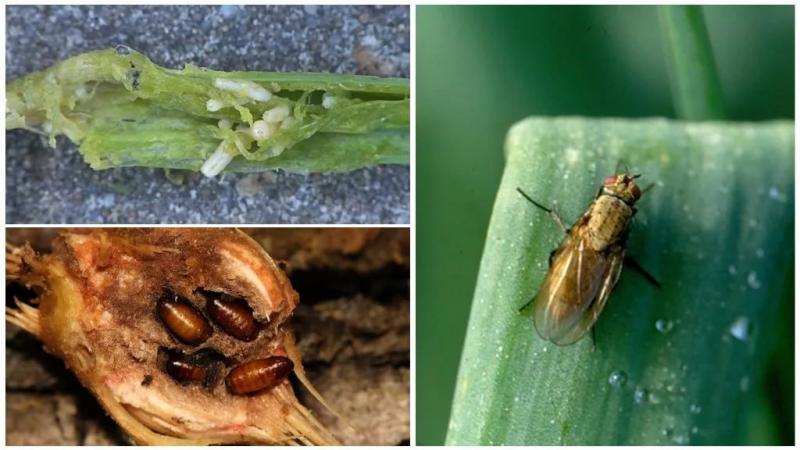 When the female reaches maturity, she begins to lay eggs near the onion. The fly lays 5-20 eggs at a time, and up to 60 eggs over the entire life cycle. Depending on the weather conditions, after 3-7 days, larvae emerge from the eggs and immediately penetrate the bulbs. They can affect the entire plant as a whole - feathers and a bulb, or they can penetrate as a whole group into one area, for example, into the lower part of the bulb, from where the roots grow.
When the female reaches maturity, she begins to lay eggs near the onion. The fly lays 5-20 eggs at a time, and up to 60 eggs over the entire life cycle. Depending on the weather conditions, after 3-7 days, larvae emerge from the eggs and immediately penetrate the bulbs. They can affect the entire plant as a whole - feathers and a bulb, or they can penetrate as a whole group into one area, for example, into the lower part of the bulb, from where the roots grow.
In the form of larvae, onion flies spend 3 weeks. During this entire period, they live inside the plant and eat it from the inside. Then the larvae enter the pupal stage. They move from the bulb to the ground next to it, and after another 20 days, young insects appear from the pupae.
Interesting! With the onset of cold weather, insects burrow into the ground to a depth of about 10 cm, pupate and hibernate in the soil until the onset of heat.
Onion fly harm to plants
Adults do not harm garden crops. They feed on nectar and pollen from wild plants, but the problem is that they lay eggs on the beds. The main danger is the larvae of flies, which can completely destroy the onion crop.
The larvae also settle inside other plants: garlic, bulbous flowers. Up to 40-50 larvae can simultaneously settle in one bulb, which eat away the juicy core from the inside.
Signs of bow defeat
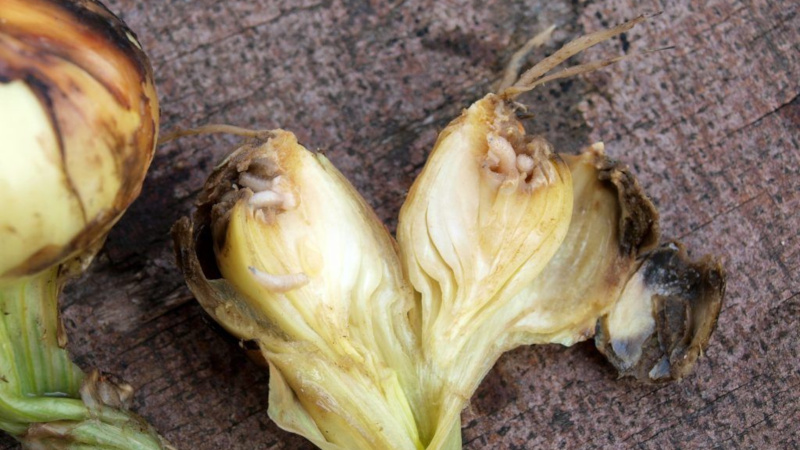
How to determine if an onion is infected with onion fly larvae?
Main features:
- onions and garlic develop more slowly than usual;
- feathers (green part) turn yellow, lethargic, dry out;
- the bulbs are soft to the touch, lethargic, with a rotten bloom;
- the onions give off an unpleasant odor like rotten vegetables.
The fight against larvae begins at the first sign in order to save the crop and prevent the reproduction of pests.
Important! Vegetables affected by larvae cannot be eaten.
How to deal with an onion fly in the garden and in the apartment
To get rid of onion flies in the garden and in the apartment, many tools are used. It remains to choose what to use - a folk remedy or a chemical.
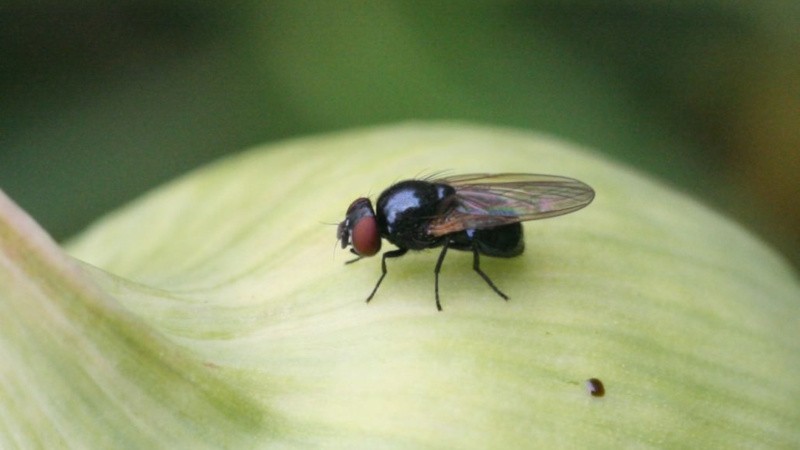
Folk remedies for onion flies
Onion processing with folk remedies is effective if you find a pest in time and there are very few infected bulbs.
The advantage of such methods is that all means are safe for humans:
- Tobacco dust. This affordable product is sold at any agricultural store. In pure form or mixed with sand in a ratio of 1: 1, onion spacing and grooves are processed.
- Ammonia. Bred 3 tbsp. l. ammonia per 10 liters of water.Water the beds in the evening, at the root, without getting on the green part. Flies may disappear after the first procedure, but for prevention repeat watering 2 more times per season.
- Wood ash. Dry branches often remain in the garden. After burning them, the resulting ash is stirred in water and poured over the beds with this solution. This environmentally friendly product will not only kill insects, but will also be a good fertilizer for the soil.
- Laundry soap. Prepare a solution of 50 g of soap in 10 liters of water and water the beds with onions.
- Sunflower ash... You can buy it in stores. The solution is prepared in a proportion of 250 g of ash per 10 liters of water and the beds are watered abundantly.
Chemicals
With the help of chemicals, they cope not only with larvae, but also with adult flies. Experts recommend using insecticides and pesticides in extreme cases when other methods are ineffective.
Strictly observe the dosage and processing methods, since chemicals are toxic and can harm the body, and onions quickly accumulate toxic substances in themselves.
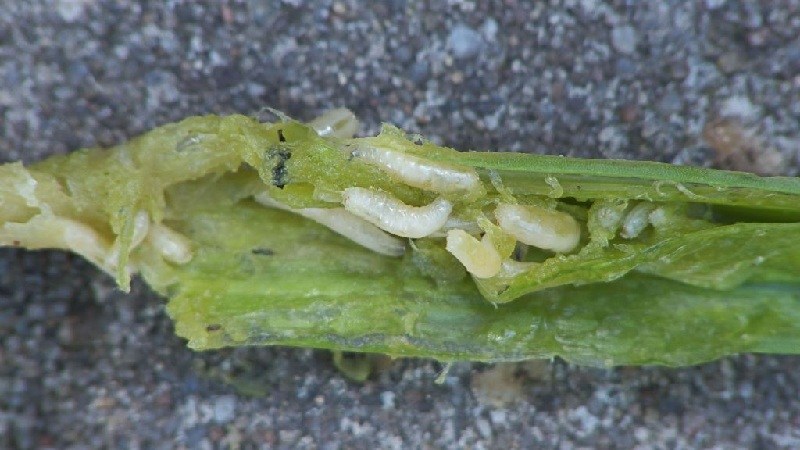
Means for the fight against onion fly:
- The drug "Summer resident" used in the form of a solution for spraying the area. The solution is diluted weakly concentrated, not more than 0.15%. Destroys up to 80% of pests.
- "Mukhoed", "Zemlin" - preparations for combating larvae that have settled in the soil. They are poured onto the surface of the earth and loosened the soil. Consumption will be 50 g per 10 m².
- The drug "Bazudin" applied during onion sowing, and then after 3 weeks into the furrows between the rows. After making, the beds must be watered.
- Effective are "Tabazol" and "Aktara" they are used for spraying bulbs and soil. The substance should not get on onion shoots.
Features of the fight against onion fly when growing in an apartment
If you grow onions in an apartment, then when the first yellowed feathers appear, start taking the same measures as in the garden so as not to lose the entire crop.
For prophylaxis, place bunches of odorous plants such as mint, tansy, wormwood on the shelves near the onion. You can make the trap in the form of a piece of apple or orange in an open bag.
The onion fly will certainly fly to the sweet smell, after which the bag must be tied up and discarded. With a large number of flies and eaten bulbs, the onions will have to be thrown away, and the soil will have to be treated with chemicals or replaced completely.
Attention! When treating a plant with chemicals, observe all precautions - wear gloves, a respirator. It is advisable not to stay indoors for 1-2 days after processing, and ventilate the apartment well.
How to get rid of flies while storing onions? After harvesting from the beds and drying, vegetables are carefully checked at least once a week. Bulbs with onion fly larvae are discarded immediately.
How to prevent onion flies
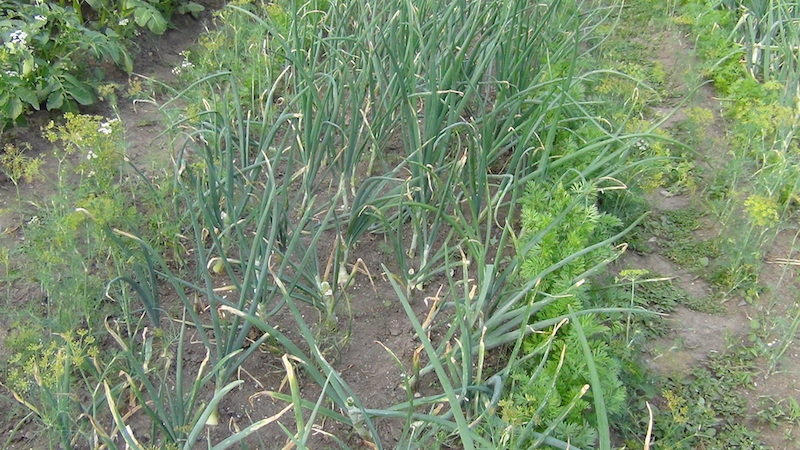
The sooner you find signs of onion flies in the beds, the more effective the fight against them will be. And with the help of simple agrotechnical methods, you will avoid their reappearance next year:
- Loosening the soil between the rows onions after each watering - flies do not lay eggs in loose soil. In the fall, after harvesting, the beds are deeply dug up. Pupae of onion flies winter in the ground and, once in the open air, die from the cold.
- Boarding time... The sooner the onions are planted in open ground, the less chance of plant infection. By the time the eggs are laid, the bulbs will have time to get stronger and will be more resistant to pests.
- They choose only high-quality planting material. Purchased onion sets may already be infested with onion fly larvae. It is better to buy it from a trusted manufacturer. If you are not sure about the quality, then you need to process the sevok before planting. To begin with, carefully sort through the entire onion and discard soft or damaged specimens. Then a weak pink solution of potassium permanganate is diluted and the sevok is soaked in it for 15-20 minutes. Dried onions can be planted.
- The place for planting onions is sunnywhere the soil will heat up quickly. Light partial shade is allowed, but not dark and damp places.
- Crop rotation rules are important... Onions are not planted in the same place for several years in a row. If the onion fly managed to settle in the soil and stayed there for the winter, then in the spring the larvae will immediately begin to eat the plantings. It is ideal to plant onions in the place where the cabbage used to grow. You can return to the previous onion landing site after 4 years, then you will interrupt the process of breeding flies.
- The correct watering regime is important for the development of healthy bulbs.... Onions do not like too dry soil; lack of moisture will make it bitter and shallow. Excess moisture will cause the bulbs to rot. After planting, the seedlings are watered once a week for a month. Then the intervals between watering are increased to 10 days. A month later, during the hottest period, they water it once every 5 days. Watering is not necessary in rainy weather. When the feathers of the onions begin to fall on the ground, this is a sign that watering should be stopped completely.
- The onion fly is deterred by the smell of carrots and tomatoes. Therefore, experienced gardeners, when planting, alternate beds of onions and carrots, tomatoes also try to plant nearby. Such a neighborhood is extremely beneficial, since the carrot fly, in turn, is afraid of the smell of onions.
- Decoction of strong-smelling herbs, such as mint, wormwood, valerian, wild rosemary, pine needles, spray onions to repel pests. Such decoctions can be used often and not to fear for the harvest, as they are environmentally friendly and completely safe.
- A solution of salt will help get rid of the onion fly. To prepare the solution, take 250-300 g of salt and dilute in 10 liters of warm water. Water the beds immediately, trying not to touch the green part of the onion. Processing is carried out at least three times per season, alternating with other means. 4-5 hours after processing, pour water on the onion.
- Onions are fed with mineral and organic fertilizers. Mineral - "Superphosphate", potassium sulfate, "Nitroammofoska", "Fertika". Organic: mullein, chicken droppings, horse manure. Fertilizers will increase the immunity of the bulbs, make them more resistant to pest control.
Tips and tricks from experienced summer residents
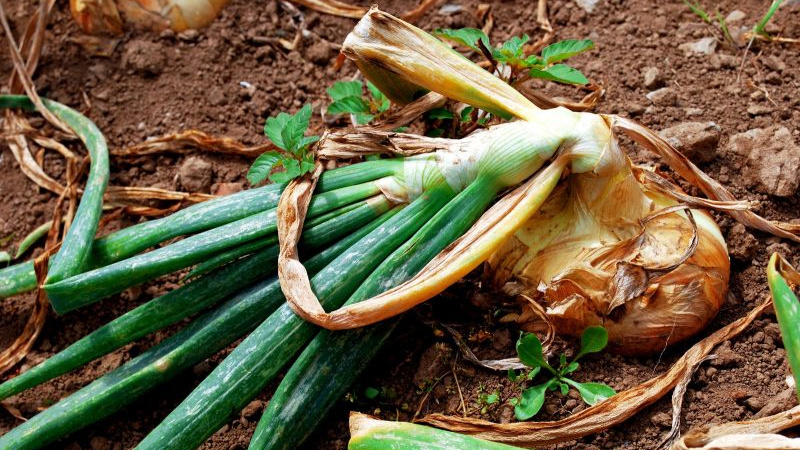
Take advantage of some more useful tips from gardeners to help you avoid mistakes:
- If larvae have already settled in the bulbs, they must be immediately pulled out and destroyed, burned. Never put affected onions in the compost pit.
- A proven way to prevent the appearance of an onion fly: 1 tsp. Dissolve the tar (you can buy it at the pharmacy, it will last for 3-4 years) in 1 liter of water and soak the onion in this solution for about 3 hours before planting. The smell of tar in the garden is almost imperceptible to humans, but scares away pests. Some summer residents grease the rags with tar and spread them between the rows of onions.
- When applied to soil or when watering onions ash, note that this tool can burn onion roots - strictly observe the dosage.
- If the case is neglected and you cannot do without chemicals, remember that greens of processed onions cannot be eaten. Especially if the plants were sprayed.
Read also:
How to eat onions for weight loss: recipes for diet meals.
Harvesting and storing onions: when it's time to dig from the garden.
Stop crying in the kitchen: learn to cut onions without tears.
Conclusion
Fighting an onion fly is easy when methods and means of getting rid of it are known. There are folk, absolutely safe remedies, and special chemicals that will save onions in severe cases. However, it is better to carry out preventive measures, starting in autumn, in order to get an excellent harvest next year, not touched by pests.